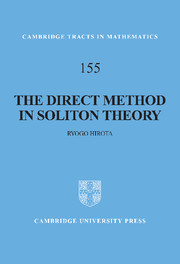Preface
Published online by Cambridge University Press: 13 August 2009
Summary
A soliton is a particular type of solitary wave, which is not destroyed when it collides with another wave of the same kind. Such behaviour is suggested by numerical simulation, but is it really possible that the soliton completely recovers its original shape after a collision? In detailed analysis of the results of such numerical simulations, some ripples can be observed after a collision, and it therefore seems that the original shape is not completely recovered. Therefore, in order to clarify whether or not solitons are destroyed through their collisions, it is necessary to find exact solutions of soliton equations.
Generally, it is a very hard task to find exact solutions of nonlinear partial differential equations, including soliton equations. Moreover, even if one manages to find a method for solving one nonlinear equation, in general such a method will not be applicable to other equations. Does there exist any successful and universal tool enabling one to solve many types of nonlinear equations which does not require a deep understanding of mathematics? For this purpose, a direct method has been investigated.
In Chapter 1, we discuss in an intuitive way the conditions under which a solitary wave is formed and we show that a nonlinear solitary wave cannot be made by the superposition of linear waves.
- Type
- Chapter
- Information
- The Direct Method in Soliton Theory , pp. ix - xiiPublisher: Cambridge University PressPrint publication year: 2004

